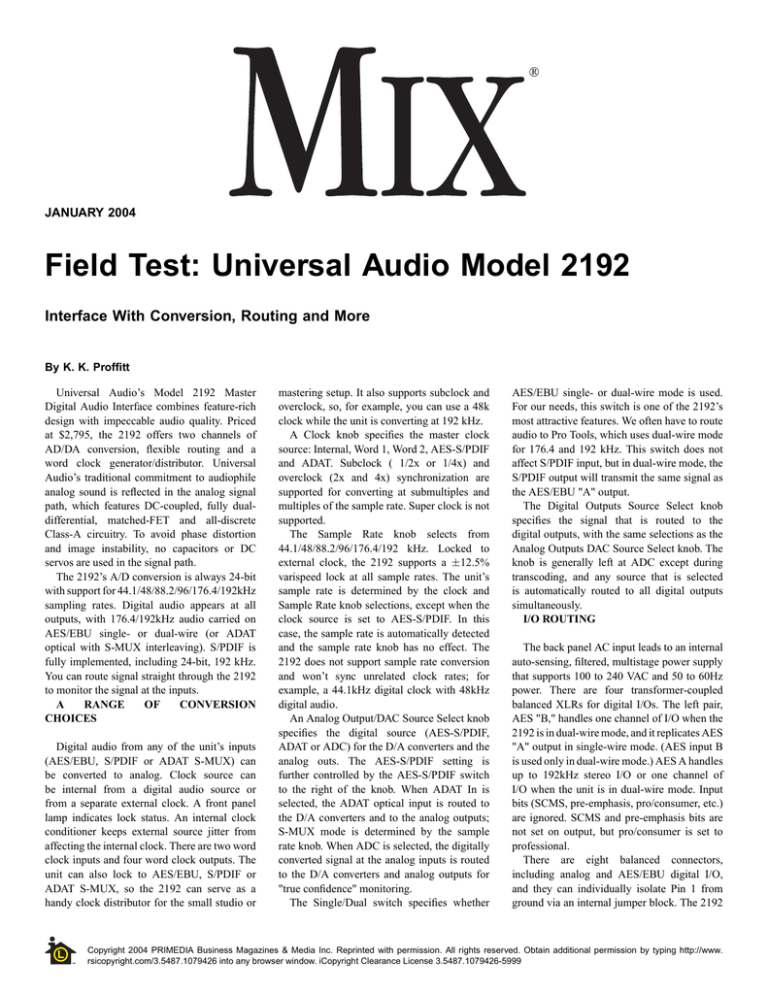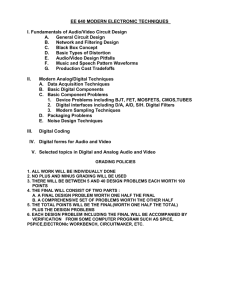
JANUARY 2004
Field Test: Universal Audio Model 2192
Interface With Conversion, Routing and More
By K. K. Proffitt
Universal Audio’s Model 2192 Master
Digital Audio Interface combines feature-rich
design with impeccable audio quality. Priced
at $2,795, the 2192 offers two channels of
AD/DA conversion, flexible routing and a
word clock generator/distributor. Universal
Audio’s traditional commitment to audiophile
analog sound is reflected in the analog signal
path, which features DC-coupled, fully dualdifferential, matched-FET and all-discrete
Class-A circuitry. To avoid phase distortion
and image instability, no capacitors or DC
servos are used in the signal path.
The 2192’s A/D conversion is always 24-bit
with support for 44.1/48/88.2/96/176.4/192kHz
sampling rates. Digital audio appears at all
outputs, with 176.4/192kHz audio carried on
AES/EBU single- or dual-wire (or ADAT
optical with S-MUX interleaving). S/PDIF is
fully implemented, including 24-bit, 192 kHz.
You can route signal straight through the 2192
to monitor the signal at the inputs.
A
RANGE
OF
CONVERSION
CHOICES
Digital audio from any of the unit’s inputs
(AES/EBU, S/PDIF or ADAT S-MUX) can
be converted to analog. Clock source can
be internal from a digital audio source or
from a separate external clock. A front panel
lamp indicates lock status. An internal clock
conditioner keeps external source jitter from
affecting the internal clock. There are two word
clock inputs and four word clock outputs. The
unit can also lock to AES/EBU, S/PDIF or
ADAT S-MUX, so the 2192 can serve as a
handy clock distributor for the small studio or
mastering setup. It also supports subclock and
overclock, so, for example, you can use a 48k
clock while the unit is converting at 192 kHz.
A Clock knob specifies the master clock
source: Internal, Word 1, Word 2, AES-S/PDIF
and ADAT. Subclock ( 1/2x or 1/4x) and
overclock (2x and 4x) synchronization are
supported for converting at submultiples and
multiples of the sample rate. Super clock is not
supported.
The Sample Rate knob selects from
44.1/48/88.2/96/176.4/192 kHz. Locked to
external clock, the 2192 supports a ±12.5%
varispeed lock at all sample rates. The unit’s
sample rate is determined by the clock and
Sample Rate knob selections, except when the
clock source is set to AES-S/PDIF. In this
case, the sample rate is automatically detected
and the sample rate knob has no effect. The
2192 does not support sample rate conversion
and won’t sync unrelated clock rates; for
example, a 44.1kHz digital clock with 48kHz
digital audio.
An Analog Output/DAC Source Select knob
specifies the digital source (AES-S/PDIF,
ADAT or ADC) for the D/A converters and the
analog outs. The AES-S/PDIF setting is
further controlled by the AES-S/PDIF switch
to the right of the knob. When ADAT In is
selected, the ADAT optical input is routed to
the D/A converters and to the analog outputs;
S-MUX mode is determined by the sample
rate knob. When ADC is selected, the digitally
converted signal at the analog inputs is routed
to the D/A converters and analog outputs for
"true confidence" monitoring.
The Single/Dual switch specifies whether
AES/EBU single- or dual-wire mode is used.
For our needs, this switch is one of the 2192’s
most attractive features. We often have to route
audio to Pro Tools, which uses dual-wire mode
for 176.4 and 192 kHz. This switch does not
affect S/PDIF input, but in dual-wire mode, the
S/PDIF output will transmit the same signal as
the AES/EBU "A" output.
The Digital Outputs Source Select knob
specifies the signal that is routed to the
digital outputs, with the same selections as the
Analog Outputs DAC Source Select knob. The
knob is generally left at ADC except during
transcoding, and any source that is selected
is automatically routed to all digital outputs
simultaneously.
I/O ROUTING
The back panel AC input leads to an internal
auto-sensing, filtered, multistage power supply
that supports 100 to 240 VAC and 50 to 60Hz
power. There are four transformer-coupled
balanced XLRs for digital I/Os. The left pair,
AES "B," handles one channel of I/O when the
2192 is in dual-wire mode, and it replicates AES
"A" output in single-wire mode. (AES input B
is used only in dual-wire mode.) AES A handles
up to 192kHz stereo I/O or one channel of
I/O when the unit is in dual-wire mode. Input
bits (SCMS, pre-emphasis, pro/consumer, etc.)
are ignored. SCMS and pre-emphasis bits are
not set on output, but pro/consumer is set to
professional.
There are eight balanced connectors,
including analog and AES/EBU digital I/O,
and they can individually isolate Pin 1 from
ground via an internal jumper block. The 2192
Copyright 2004 PRIMEDIA Business Magazines & Media Inc. Reprinted with permission. All rights reserved. Obtain additional permission by typing http://www.
rsicopyright.com/3.5487.1079426 into any browser window. iCopyright Clearance License 3.5487.1079426-5999
Page 2
adheres to the universal Pin 2 Hot standard.
Dual-stacked RCA connectors handle
S/PDIF with unbalanced, transformer-driven
output and AC-coupled input. Input/output
bitstreams are set the same as AES/EBU.
When the clock knob is set to AES-S/PDIF
and the digital outputs knob is not set to
AES-S/PDIF, the S/PDIF signal is used for
clocking only.
Six BNC connectors handle word clock.
The first four are 75-ohm, 5-volt CMOS
drive outputs; the second two are AC-coupled,
75-ohm inputs. Clock delay from input to output
is 50 nanoseconds maximum and is negativeedge-aligned when synchronized at a multiple
or submultiple rate.
ADAT optical I/O comprises two Toslink
connectors with dual in-line reinforced optical
TX/RX. Channel usage varies from two for
44.1/48 kHz to all eight for 176.4/192 kHz. Like
S/PDIF, the ADAT input can be used for clock
only.
IN THE STUDIO WITH THE 2192
Connected to any piece of my digital gear, I
was pleased when the 2192 accepted the signal
and could route it elsewhere. The excellent
manual contains "recipes" for routing, as well
as diagrams for mastering and DAW setups,
including Pro Tools—HD. I could use it for
dual-wire 192kHz projects with my Pro Tools
Accel system and easily switch it over to ADAT
S-MUX or S/PDIF from my RME Hammerfall
9652 Nuendo system. I ran into S/PDIF failure
with another converter when routing it from the
RME, so I was glad to see that the 2192 locked
immediately and performed flawlessly. As you
can transfer audio between AES/EBU, S/PDIF
and ADAT-SMUX in real time, the 2192 is great
for transcoding.
The 2192 is hot — literally. In rackmount
installs, leave space above and below the unit.
When stacked in open air and separated by
1/2-inch spacers, the top was much cooler than
when it simply rested on a flat surface.
Ten-segment LEDs monitor stereo input and
output. They are tied to the converters, not the
analog trims. The red clip segments are driven
by digital circuitry; the other nine segments
are driven by analog metering circuitry and
calibrated to reflect digital signal. The unit is
factory calibrated at 0 dBFS = +22 dBu (and -18
dBFS = +4 dBu), but this is adjustable using rear
panel analog line trims next to each I/O XLR.
I’ve long been an advocate of adjustable trims
for calibration. It’s a must for critical mastering
situations and for times when engineers need
to have converters set at maximum sensitivity
to capture low-level detail in the analog source.
Still, I wish the trims were located on the front.
For those who calibrate early and often (rather
than "set and forget"), it would make life easier.
I’ll hate to send this box back to Universal
Audio. We had some great sessions with
it. For recording a guitar directly into Pro
Tools, the 2192 mated wonderfully with my
Millennia Origin STT-1. Jazz chords were rich
and creamy, while chicken pickin’ chits were
snappy without being overbearing. All sample
rates sounded great, but I found that the more I
use 192 kHz, the more that "something extra I
can’t describe" hooks me into using loads and
loads of disk space.
The crème de la crème example of the
accuracy and beauty of the 2192’s conversion
capabilities was when I used an AKG C426B
dual-capsule condenser mic in X-Y mode with
figure-8s. I ran this through John Hardy M-1
preamps. JamSync, which I co-own, has a room
upstairs for recording guitars and drums. It’s
moderately reflective with plaster walls and
various movable acoustic "room shapers." I
tracked using my old Fender Princeton and
favorite hot-rodded Strat, experimenting with
amp positions, as well as checking the system
with vocals. I also recorded some drum tracks
with the mic in various positions.
As I listened back, several things caught my
ear: the clarity of the instruments, the depth and
breadth of space, and the richness of detail. At
192 kHz, I was amazed at the results. You could
practically hear the ridges of the cymbal as the
stick was slowly scraped along it to produce a
shimmer of sound — gorgeous. It was one of
those moments that reminded me of the reason
I became an audio engineer: for the sheer joy of
being able to hear the stark beauty of sound.
Another telling moment came when my
partner, Joel, walked in the room and was
shocked to find out that I wasn’t playing, but
listening back.
Universal Audio enters the converter market
with a clear-cut winner, the Model 2192
Master Digital Audio Interface. The 2192
provides routing flexibility with exquisite
sound. Needless to say, I’d be very happy if
Universal Audio would bring out an 8-channel
version of the 2192. Until then, we’ll have to
drive four of the units via word clock for
surround sound, a small sacrifice to make for
achieving such excellent results.
Universal Audio, 831/466-3737, www.
uaudio.com.
K. K. Proffitt is the chief engineer at
JamSync, a Nashville-based studio specializing
in surround sound production.
Copyright 2004 PRIMEDIA Business Magazines & Media Inc. Reprinted with permission. All rights reserved. Obtain additional permission by typing http://www.
rsicopyright.com/3.5487.1079426 into any browser window. iCopyright Clearance License 3.5487.1079426-5999




